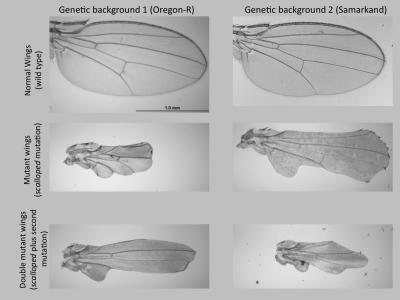Why one person’s mutation kills when the same mutation in someone else is benign
Scientists have begun to understand how the rest of the genome interacts with mutations, explaining why not everyone with identical genetic mutations develops a disease.
In the current issue of PLOS Genetics, Michigan State University genetic scientists have begun to understand how the rest of the genome interacts with such mutations to cause the differences we see among individuals.
“It’s been known for a while that genetic mutations can modify each other’s effects,” said Ian Dworkin, MSU associate professor of zoology and co-author of the paper. “And we also know that the subtle differences in an individual’s genome - what scientists call wild type genetic background - also affects how mutations are manifested.”
Dworkin and Sudarshan Chari, zoology doctoral student and the paper’s lead author, wanted to know how common it was for wild type genetic background to alter the way genetic mutations interact with each other. This is the first time that it’s been examined in a systematic manner, Dworkin added.
Using the fruit fly genome, the researchers found that wild type genetic background affected the outcomes of interactions between genetic mutations about 75% of the time. This could have huge implications in how scientists construct genetic networks - maps of how genes interact with each other.
“It may be that some crucial portions of genetic networks are missing,” he said. “It also seems that network descriptions are more fluid than we thought.”
Fruit flies have been called humans with wings, genetically speaking, due to their similarities. By focusing on wings and a genetic mutation that alters them, the researchers demonstrated the influence of wild type genetic background was actually quite common.

The broader implication for humans is that even for diseases with a simple genetic basis, variation in the genome may matter for both understanding and treatment, Dworkin said.
This new insight explains how, in an example like breast cancer, every woman’s genetic background is likely influencing how the mutation is expressed, causing different disease outcomes. The research also may help explain why some people benefit from a specific treatment for a disease, while others get no benefits or become resistant to a drug after a short time.
It’s likely that most diseases with a suspected genetic component, such as cancer, asthma or Parkinson’s, involve reactions between more than one set of genes. For Dworkin and Chari, the next step is to tease apart the intricacies of what’s happening.
“Is it just the two pairs of genes that are interacting?” Dworkin asked. “Or is it that the two genes are interacting and then many other genes are modifying that reaction? This will help us understand how much complexity is involved.”
Blood test could be used to diagnose Parkinson's earlier
Researchers have developed a new method that requires only a blood draw, offering a non-invasive...
Cord blood test could predict a baby's risk of type 2 diabetes
By analysing the DNA in cord blood from babies born to mothers with gestational diabetes,...
DNA analysis device built with a basic 3D printer
The Do-It-Yourself Nucleic Acid Fluorometer, or DIYNAFLUOR, is a portable device that measures...



